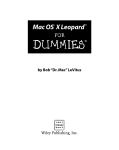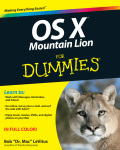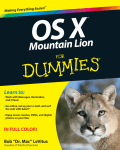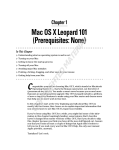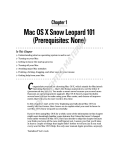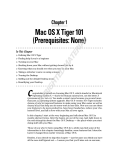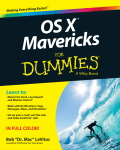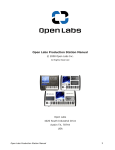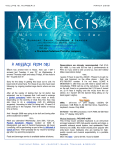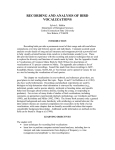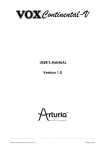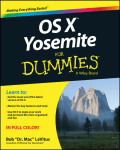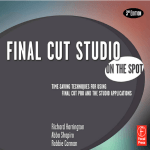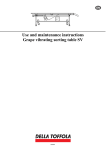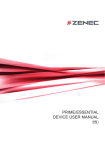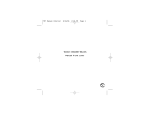Download DUMmIES‰
Transcript
Mac OS X Tiger ® ™ FOR DUMmIES ‰ by Bob LeVitus Mac OS X Tiger ® ™ FOR DUMmIES ‰ Mac OS X Tiger ® ™ FOR DUMmIES ‰ by Bob LeVitus Mac OS® X Tiger™ For Dummies® Published by Wiley Publishing, Inc. 111 River Street Hoboken, NJ 07030-5774 www.wiley.com Copyright © 2005 by Wiley Publishing, Inc., Indianapolis, Indiana Published by Wiley Publishing, Inc., Indianapolis, Indiana Published simultaneously in Canada No part of this publication may be reproduced, stored in a retrieval system or transmitted in any form or by any means, electronic, mechanical, photocopying, recording, scanning or otherwise, except as permitted under Sections 107 or 108 of the 1976 United States Copyright Act, without either the prior written permission of the Publisher, or authorization through payment of the appropriate per-copy fee to the Copyright Clearance Center, 222 Rosewood Drive, Danvers, MA 01923, (978) 750-8400, fax (978) 646-8600. Requests to the Publisher for permission should be addressed to the Legal Department, Wiley Publishing, Inc., 10475 Crosspoint Blvd., Indianapolis, IN 46256, (317) 572-3447, fax (317) 572-4355, or online at http://www.wiley.com/go/permissions. Trademarks: Wiley, the Wiley Publishing logo, For Dummies, the Dummies Man logo, A Reference for the Rest of Us!, The Dummies Way, Dummies Daily, The Fun and Easy Way, Dummies.com, and related trade dress are trademarks or registered trademarks of John Wiley & Sons, Inc. and/or its affiliates in the United States and other countries, and may not be used without written permission. Mac OS and Tiger are trademarks or registered trademarks of Apple Computer, Inc. in the U.S. and other countries. All other trademarks are the property of their respective owners. Wiley Publishing, Inc., is not associated with any product or vendor mentioned in this book. LIMIT OF LIABILITY/DISCLAIMER OF WARRANTY: THE PUBLISHER AND THE AUTHOR MAKE NO REPRESENTATIONS OR WARRANTIES WITH RESPECT TO THE ACCURACY OR COMPLETENESS OF THE CONTENTS OF THIS WORK AND SPECIFICALLY DISCLAIM ALL WARRANTIES, INCLUDING WITHOUT LIMITATION WARRANTIES OF FITNESS FOR A PARTICULAR PURPOSE. NO WARRANTY MAY BE CREATED OR EXTENDED BY SALES OR PROMOTIONAL MATERIALS. THE ADVICE AND STRATEGIES CONTAINED HEREIN MAY NOT BE SUITABLE FOR EVERY SITUATION. THIS WORK IS SOLD WITH THE UNDERSTANDING THAT THE PUBLISHER IS NOT ENGAGED IN RENDERING LEGAL, ACCOUNTING, OR OTHER PROFESSIONAL SERVICES. IF PROFESSIONAL ASSISTANCE IS REQUIRED, THE SERVICES OF A COMPETENT PROFESSIONAL PERSON SHOULD BE SOUGHT. NEITHER THE PUBLISHER NOR THE AUTHOR SHALL BE LIABLE FOR DAMAGES ARISING HEREFROM. THE FACT THAT AN ORGANIZATION OR WEBSITE IS REFERRED TO IN THIS WORK AS A CITATION AND/OR A POTENTIAL SOURCE OF FURTHER INFORMATION DOES NOT MEAN THAT THE AUTHOR OR THE PUBLISHER ENDORSES THE INFORMATION THE ORGANIZATION OR WEBSITE MAY PROVIDE OR RECOMMENDATIONS IT MAY MAKE. FURTHER, READERS SHOULD BE AWARE THAT INTERNET WEBSITES LISTED IN THIS WORK MAY HAVE CHANGED OR DISAPPEARED BETWEEN WHEN THIS WORK WAS WRITTEN AND WHEN IT IS READ. For general information on our other products and services, please contact our Customer Care Department within the U.S. at 800-762-2974, outside the U.S. at 317-572-3993, or fax 317-572-4002. For technical support, please visit www.wiley.com/techsupport. Wiley also publishes its books in a variety of electronic formats. Some content that appears in print may not be available in electronic books. Library of Congress Control Number: 2005923419 ISBN-13: 978-0-7645-7675-1 ISBN-10: 0-7645-7675-5 Manufactured in the United States of America 10 9 8 7 6 5 4 3 2 1 1O/RQ/QV/QV/IN About the Author Bob LeVitus, often referred to as “Dr. Mac,” has written nearly 50 popular computer books, including Dr. Mac: The OS X Files and Mac OS 9 For Dummies for Wiley Publishing, Inc.; Stupid Mac Tricks and Dr. Macintosh for Addison-Wesley; and The Little iTunes Book, 3rd Edition and The Little iDVD Book, 2nd Edition for Peachpit Press. His books have sold more than a million copies worldwide. Bob has penned the popular Dr. Mac column for the Houston Chronicle for more than six years and has been published in dozens of computer magazines over the past 15 years. His achievements have been documented in major media around the world. (Yes, that was him juggling a keyboard in USA Today a few years back!) Bob is known for his expertise, trademark humorous style, and ability to translate techie jargon into usable and fun advice for regular folks. Bob is also a prolific public speaker, presenting more than 100 Macworld Expo training sessions in the U.S. and abroad, keynote addresses in three countries, and Macintosh training seminars in many U.S. cities. (He also won the Macworld Expo MacJeopardy World Championship three times before retiring his crown.) Bob is considered one of the world’s leading authorities on Mac OS. From 1989 to 1997, he was a contributing editor/columnist for MacUser magazine, writing the Help Folder, Beating the System, Personal Best, and Game Room columns at various times. In 2004, LeVitus founded his most ambitious undertaking yet, Doctor Mac Direct LLC (www.doctormacdirect.com), a company that provides expert technical help and training to Mac users, in real time and at reasonable prices, via telephone, e-mail, and/or its own unique Internet-enabled remote control software. If you’re having problems with your Mac, you ought to give them a try! Prior to giving his life over to computers, LeVitus spent years at Kresser/ Craig/ D.I.K. (a Los Angeles advertising agency and marketing consultancy) and its subsidiary, L & J Research. He holds a B.S. in Marketing from California State University. Dedication This book is dedicated to my wife, Lisa, who taught me almost everything I know about almost everything except computers. Author’s Acknowledgments Special thanks to everyone at Apple who helped me turn this book around in record time: Keri Walker, Pam Bennett, Nathalie Welch, Greg (Joz) Joswiak, and all the rest. I couldn’t have done it without you. Thanks also to super-agent Carole “Swifty-for-life” McClendon, for dealmaking beyond the call of duty, again. You’ve been my agent nearly 20 years, and I want you to know that you’re a treasure. Big-time thanks to the gang at Wiley: Bob “Is the damn thing done yet?” Woerner, Nicole “Whipcrcker VI” Sholly, Andy “Big Boss Man” Cummings, Barry “Still no humorous nickname” Pruett, technical editor Dennis R. Cohen, who did a rocking job, and all the others. And additional extra special thanks to Dennis R. Cohen for technical support and for updating several chapters for me when time got short. It’s been an honor and a privilege to work with the only guy I know who’s been using OS X longer than me. You rock, dude! Thanks also to my family and friends, for putting up with me during my alltoo lengthy absences during this book’s gestation. And thanks to Saccone’s Pizza, Lucky Dog Chicago-style hot dogs, John Muller Texas BBQ, Taco Cabana, Bass Ale, Sam Adams, and ShortStop for sustenance. And finally, thanks to you, gentle reader, for buying this book. Publisher’s Acknowledgments We’re proud of this book; please send us your comments through our online registration form located at www.dummies.com/register/. Some of the people who helped bring this book to market include the following: Acquisitions, Editorial, and Media Development Composition Services Project Editor: Nicole Sholly Senior Acquisitions Editor: Bob Woerner Senior Copy Editor: Barry Childs-Helton Technical Editor: Dennis R. Cohen Project Coordinator: Maridee Ennis Layout and Graphics: Carl Byers, Andrea Dahl, Lauren Goddard, Denny Hager, Joyce Haughey, Melanee Prendergast, Heather Ryan Editorial Manager: Kevin Kirschner Proofreaders: Jessica Kramer, Linda Morris, Joe Niesen, Carl William Pierce Media Development Manager: Laura VanWinkle Indexer: TECHBOOKS Production Services Media Development Supervisor: Richard Graves Editorial Assistant: Amanda Foxworth Cartoons: Rich Tennant (www.the5thwave.com) Publishing and Editorial for Technology Dummies Richard Swadley, Vice President and Executive Group Publisher Andy Cummings, Vice President and Publisher Mary Bednarek, Executive Acquisitions Director Mary C. Corder, Editorial Director Publishing for Consumer Dummies Diane Graves Steele, Vice President and Publisher Joyce Pepple, Acquisitions Director Composition Services Gerry Fahey, Vice President of Production Services Debbie Stailey, Director of Composition Services Contents at a Glance Introduction ................................................................1 Part I: Introducing Mac OS X Tiger ..............................9 Chapter 1: Mac OS X Tiger 101 (Prerequisites: None) ................................................11 Chapter 2: I Think Icon, I Think Icon . . . .......................................................................27 Chapter 3: About Windows (Not the Microsoft Kind) and Menus ............................53 Part II: Rounding Out Your Basic Training ...................95 Chapter 4: Newfangled Finder .......................................................................................97 Chapter 5: Mastering the Save Sheet and the Open Dialog .....................................117 Chapter 6: File Management without Tearing Your Hair Out ...................................133 Chapter 7: Haggling with Removable Media ..............................................................161 Chapter 8: Back Up Now or Regret It Later ................................................................169 Part III: Doing Stuff with Your Mac ..........................177 Chapter 9: Internet-Working .........................................................................................179 Chapter 10: Publish or Perish: The Fail-Safe Guide to Printing ...............................203 Chapter 11: Application Overload ...............................................................................223 Chapter 12: The Classic Environment: Like Mac OS 9, Only Better ........................257 Chapter 13: What Your Mac Prefers ............................................................................271 Part IV: Networking & Troubleshooting ......................305 Chapter 14: Mine! Miiiiine! Sharing Your Mac and Liking It ......................................307 Chapter 15: Troubleshooting Mac OS X .....................................................................347 Part V: The Part of Tens ...........................................359 Chapter 16: Ten (Or So) Ways to Speed Up Your Mac Experience ..........................361 Chapter 17: Ten (Or So) Ways to Make Your Mac Better by Throwing Money at It ...................................................................................................................371 Chapter 18: Ten (Or So) Great Web Sites for Mac Freaks .........................................377 Chapter 19: Ten (Or So) Mac OS X Apps That You Might Need Someday .............381 Appendix: Installing or Reinstalling Mac OS X 10.4 Tiger (Only If You Have To) .............................389 Index .......................................................................397 Table of Contents Introduction .................................................................1 About This Book ..............................................................................................1 What You Won’t Find in this Book .................................................................2 Conventions Used in This Book ....................................................................3 What You’re Not to Read ................................................................................4 Foolish Assumptions ......................................................................................4 How This Book Is Organized ..........................................................................4 Part I: Introducing Mac OS X ................................................................5 Part II: Rounding Out Your Basic Training .........................................5 Part III: Doing Stuff with Your Mac ......................................................5 Part IV: Networking and Troubleshooting ..........................................5 Part V: The Part of Tens ........................................................................6 The Appendix .........................................................................................6 Icons Used in This Book .................................................................................6 Where to Go from Here ...................................................................................7 Part I: Introducing Mac OS X Tiger ...............................9 Chapter 1: Mac OS X Tiger 101 (Prerequisites: None) . . . . . . . . . . . . .11 Gnawing to the Core of OS X ........................................................................12 A Safety Net for the Absolute Beginner (Or Any User) ............................14 Turning the dang thing on ..................................................................14 What you should see on startup .......................................................15 Shutting down properly ......................................................................18 A few things you should definitely NOT do with your Mac ...........19 Point-and-click boot camp .................................................................20 Touring the Desktop .....................................................................................21 Sniffing Out the Default Desktop Icons .......................................................23 Picture This: A Picture on Your Desktop ....................................................24 Chapter 2: I Think Icon, I Think Icon . . . . . . . . . . . . . . . . . . . . . . . . . . . .27 What You Get (In a Stock Dock) ..................................................................27 A quick introduction to using the Dock ............................................28 The default icons of the Dock ............................................................30 Don’t want it? Trash it ........................................................................31 Delving Deeper into the Dock ......................................................................32 More about Dock icons .......................................................................33 Resizing the Dock ................................................................................33 Adding and removing Dock icons .....................................................34 What should you put in your Dock? .................................................36 Setting your Dock preferences ...........................................................38 xii Mac OS X Tiger For Dummies Other Icons in OS X Tiger .............................................................................39 Aliases: Greatest Thing Since Sliced Bread ................................................42 Creating aliases ....................................................................................43 Deleting aliases ....................................................................................44 Hunting down an alias’ parent ...........................................................45 Doing More with Your Icons ........................................................................45 Open sez me! Opening icons ..............................................................45 Getting rid of icons ..............................................................................46 Playing the icon name game: renaming icons ..................................46 Selecting multiple icons ......................................................................47 Info-mation .....................................................................................................49 Chapter 3: About Windows (Not the Microsoft Kind) and Menus . . .53 Anatomy of a Window ...................................................................................54 Top o’ the window to ya! ....................................................................56 A scroll new world ...............................................................................56 (Hyper) Active windows .....................................................................58 Dialog Dealie-Boppers ..................................................................................59 Working with Windows .................................................................................61 Resizing windows ................................................................................62 Resizing window panes .......................................................................62 Moving windows ..................................................................................62 Shutting yo’ windows ..........................................................................62 Menu Basics ...................................................................................................63 Contextual menus: They’re sooo sensitive ......................................65 Disabled options ..................................................................................67 Submenus .............................................................................................68 Keyboard shortcut commands ..........................................................68 It’s elliptical ..........................................................................................71 Underneath the Apple Menu Tree ...............................................................71 Your Constant Companion: The Application Menu ..................................74 File Management and More: Meet the File Menu ......................................78 The Edit Menu (Which Shoulda Been Called the Clipboard Menu) ........82 Comprehending the Clipboard ..........................................................83 Checking out the main Edit menu items ...........................................84 A View from a Window: The View Menu ....................................................85 Going Places: Checking Out Go Menu Items ..............................................87 Window Dressing ...........................................................................................89 Not Just a Beatles Movie: Help and the Help Menu ..................................91 Part II: Rounding Out Your Basic Training ...................95 Chapter 4: Newfangled Finder . . . . . . . . . . . . . . . . . . . . . . . . . . . . . . . . .97 Getting to Know the Finder ..........................................................................97 Belly Up to the Bar(s): The Toolbar and Sidebar ......................................99 Table of Contents Navigating the Finder: Up, Down, and Backwards ..................................101 Like a roadmap: The current folder drop-down menu .................101 Hither and yon: The Forward and Back buttons ...........................103 Customize Your Finder Windows ..............................................................103 Column view .......................................................................................103 Icon view .............................................................................................105 List view ..............................................................................................105 On Using View Options .....................................................................108 Making It Your Very Own Finder: Introducing Finder Preferences .......112 Using the General pane .....................................................................113 Using the Labels pane .......................................................................114 Using the Sidebar pane .....................................................................114 Using the Advanced pane .................................................................115 Customizing the Finder with Folder Actions .................................115 Chapter 5: Mastering the Save Sheet and the Open Dialog . . . . . . .117 Saving Your Document Before It’s Too Late .............................................118 Checking out the Save sheet ............................................................119 Looks like Save, acts like Save — why’s it called Save As? ..........128 Open Sez Me ................................................................................................129 Knowing the differences between Open dialogs and Save sheets .....................................................................................130 Knowing what the Open dialog doesn’t show you . . . ..................131 Chapter 6: File Management without Tearing Your Hair Out . . . . . .133 Working with Files and Folders .................................................................134 Files versus folders ...........................................................................134 Creating new folders .........................................................................135 Navigating Nested Folders .........................................................................136 Moving files and folders ...................................................................137 Copying files or folders .....................................................................138 Opening files with drag-and-drop ....................................................140 Assigning an application to a document or document type ........142 Organizing your stuff with subfolders ............................................143 Spring-loaded folders ........................................................................144 Getting Up to Speed with the Mac OS X Folder Structure .....................146 The Mac OS X folder structure in depth .........................................147 There’s no place like Home ..............................................................150 Your Library card ..............................................................................152 Finding Your Stuff, Fast ...............................................................................153 The Search box in Finder windows .................................................154 Spotlight .............................................................................................156 Smart Folders .....................................................................................158 Chapter 7: Haggling with Removable Media . . . . . . . . . . . . . . . . . . . .161 Comprehending Disks .................................................................................162 Some Disks Need to be Formatted First ...................................................162 Moving and Copying Disk Icons ................................................................163 xiii xiv Mac OS X Tiger For Dummies Surprise: Your PC Disks Work, Too! ..........................................................163 Burning CDs and DVDs ...............................................................................164 Getting Disks Out of Your Mac ..................................................................167 Chapter 8: Back Up Now or Regret It Later . . . . . . . . . . . . . . . . . . . . .169 Backing Up Is (Not) Hard to Do .................................................................170 Backing up by using the manual, brute-force method ..................170 Backing up by using the manual, brute-force method with Burn Folders ..........................................................................170 Backing up by using commercial backup software .......................171 Why You Need Two Sets of Backups ........................................................174 Part III: Doing Stuff with Your Mac ...........................177 Chapter 9: Internet-Working . . . . . . . . . . . . . . . . . . . . . . . . . . . . . . . . . .179 A Brief Internet Overview ..........................................................................179 Setting Up for Surfing ..................................................................................180 It starts with the modem ..................................................................181 High-speed connections ...................................................................182 Your Internet service provider and you .........................................182 Browsing the Web with Safari ....................................................................183 Getting up and running with Safari .................................................183 Searching with Sherlock .............................................................................187 A quick look at Sherlock’s features .................................................188 Searching with Sherlock ...................................................................188 Checking out Help Center ................................................................191 Getting Your E-Mail with Mail ....................................................................191 Composing a new message ..............................................................192 Checking your mail ...........................................................................193 Dealing with spam .............................................................................193 Changing your preferences ..............................................................194 But wait — there’s more! ..................................................................195 And don’t forget Address Book .......................................................195 A Quick Overview of .Mac ..........................................................................197 Communicating via iChat AV .....................................................................199 Gimme an A! Gimme a V! ............................................................................200 Chapter 10: Publish or Perish: The Fail-Safe Guide to Printing . . . .203 Before Diving In . . . .....................................................................................203 Ready: Connecting and Adding Your Printer ...........................................204 Connecting your printer ...................................................................204 Setting up a printer for the first time ..............................................206 Set: Setting Up Your Document with Page Setup ....................................209 Go: Printing with the Print Sheet ..............................................................211 Printing a document ..........................................................................211 Choosing from among different printers ........................................213 Choosing custom settings ................................................................213 Table of Contents Previewing Your Documents ......................................................................217 Just the Fax . . . ............................................................................................218 Font Mania ...................................................................................................219 Installing new fonts ...........................................................................221 Types of fonts ....................................................................................221 Chapter 11: Application Overload . . . . . . . . . . . . . . . . . . . . . . . . . . . . .223 Folder Full of Apps ......................................................................................224 Address Book .....................................................................................224 Apple Graphing Calculator ...............................................................224 AppleScript .........................................................................................225 Automator ..........................................................................................226 Calculator ...........................................................................................229 Chess ...................................................................................................230 Dashboard ..........................................................................................231 Dictionary ...........................................................................................236 DVD Player .........................................................................................236 Font Book ...........................................................................................237 iCal .......................................................................................................239 iChat ....................................................................................................240 Image Capture ....................................................................................241 Internet Connect ................................................................................241 iSync ....................................................................................................241 iTunes .................................................................................................242 Mail ......................................................................................................242 Preview ...............................................................................................242 QuickTime Player ..............................................................................242 Safari ...................................................................................................242 Sherlock ..............................................................................................243 Stickies ................................................................................................243 System Preferences ...........................................................................244 TextEdit ...............................................................................................244 Utilities ................................................................................................244 Chapter 12: The Classic Environment: Like Mac OS 9, Only Better . . . . . . . . . . . . . . . . . . . . . . . . . . . . . . . . . . . . . . . . . . . . . . . . .257 You Can Call It Classic ................................................................................258 What’s so great about Classic? ........................................................259 Doin’ the Classic dance ...................................................................259 Working with Classic ...................................................................................260 Launching Classic (or letting it launch itself) ................................260 Opening a Classic app .......................................................................262 Getting oriented (“Toto, we’re not in OS X, anymore . . .”) ..........263 Getting back to OS X .........................................................................265 Setting Classic preferences ..............................................................265 Getting more info on Classic ............................................................267 Booting from Mac OS 9.2.2 ...............................................................267 xv xvi Mac OS X Tiger For Dummies Chapter 13: What Your Mac Prefers . . . . . . . . . . . . . . . . . . . . . . . . . . .271 Introducing System Preferences ...............................................................271 Using System Preferences ..........................................................................272 Unlocking a preference .....................................................................274 Locking a preference .........................................................................276 Setting Preferences .....................................................................................276 Personal preferences ........................................................................276 Hardware preferences .......................................................................286 Internet & Network preferences ......................................................292 System System preferences (kind of redundant) ..........................296 Part IV: Networking & Troubleshooting ......................305 Chapter 14: Mine! Miiiiine! Sharing Your Mac and Liking It . . . . . .307 Introducing File Sharing .............................................................................308 Portrait of home office networking .................................................310 Three ways to build a network ........................................................310 Setting Up File Sharing ................................................................................312 Turning on file sharing ......................................................................312 Starting AppleTalk .............................................................................314 Sharing with TCP/IP ..........................................................................314 Access and Privileges: Who Can Do What ...............................................316 Users and groups and guests ...........................................................316 Creating users ....................................................................................317 Mac OS X knows best: Folders shared by default .........................323 Sharing a folder or disk by setting privileges ................................324 Useful settings for access privileges ...............................................329 Consummating the Act of Sharing ............................................................332 Connecting to a shared disk or folder on a remote ......................333 Unsharing a folder .............................................................................335 Disconnecting from a shared volume .............................................337 Changing your password ..................................................................337 Setting up shortcuts to remote volumes (and folders) ................339 Connecting to your own computer from a remote computer .....340 Chapter 15: Troubleshooting Mac OS X . . . . . . . . . . . . . . . . . . . . . . . .347 Dem Ol’ Sad Mac Chimes of Doom Blues .................................................347 The ultimate startup disk: The OS X installation CD ....................348 Booting from CD-ROM .......................................................................349 Question Mark and the Mysterians ...........................................................351 Step 1: Run First Aid ..........................................................................352 Step 2: Safe Boot into Safe Mode .....................................................354 Step 3: Zapping the PRAM ................................................................356 Step 4: Reinstalling OS X ...................................................................356 Step 5: Take your Mac in for repair .................................................357 If You Crash at Startup ...............................................................................357 Table of Contents Part V: The Part of Tens ............................................359 Chapter 16: Ten (Or So) Ways to Speed Up Your Mac Experience . . . . . . . . . . . . . . . . . . . . . . . . . . . . . . . . . . . . . . .361 Use Those Keyboard Shortcuts .................................................................361 Learn to Type Better ...................................................................................363 Resolution: It’s Not Just for New Year’s Anymore ...................................364 A Mac with a View — and Preferences, Too ............................................365 When bigger isn’t better ...................................................................366 Calculated moves ..............................................................................366 Getting ahead-er and other stuff .....................................................367 Get a New, Faster Model or Upgrade Yours .............................................367 Get an Accelerator ......................................................................................368 Get an Accelerated Graphics Card ............................................................368 Get a New Hard Drive .................................................................................368 Add Storage with FireWire or USB 2 Drives .............................................369 Chapter 17: Ten (Or So) Ways to Make Your Mac Better by Throwing Money at It . . . . . . . . . . . . . . . . . . . . . . . . . . . . . . . . . . . . .371 RAM ...............................................................................................................371 Backup Software ..........................................................................................372 A Better Monitor (or a Second One) .........................................................372 A Fast Internet Connection ........................................................................372 Additional Hard/Removable/Optical Drive(s) .........................................373 Games ...........................................................................................................373 Multimedia Titles ........................................................................................374 Some Big Honking Speakers with a Subwoofer .......................................374 A New Mouse and/or Keyboard ................................................................374 A PowerBook or an iBook ..........................................................................375 A New Mac ...................................................................................................375 Chapter 18: Ten (Or So) Great Web Sites for Mac Freaks . . . . . . . . .377 Chapter 19: Ten (Or So) Mac OS X Apps That You Might Need Someday . . . . . . . . . . . . . . . . . . . . . . . . . . . . . . . . . . . . . . . . . . . . .381 Web Sharing .................................................................................................381 FTP Access ...................................................................................................382 ColorSync Utility .........................................................................................383 Image Capture ..............................................................................................384 Text to Speech .............................................................................................385 VoiceOver .....................................................................................................385 Speech Recognition ....................................................................................386 NetInfo Manager ..........................................................................................386 UNIX Tools: Terminal, Console, and Activity Monitor ............................387 Terminal ..............................................................................................387 Console ...............................................................................................388 Activity Monitor ................................................................................388 xvii xviii Mac OS X Tiger For Dummies Appendix: Installing or Reinstalling Mac OS X 10.4 Tiger (Only If You Have To) .............................389 How to Install (or Reinstall) Mac OS X .....................................................390 Getting Set Up with Setup Assistant .........................................................393 Index........................................................................397 Introduction Y ou made the right choice twice: Mac OS X Tiger and this book. Take a deep breath and get ready to have a rollicking good time. That’s right. This is a computer book, but this is going to be fun. What a concept! Whether you’re brand spanking new to the Mac or a grizzled old Mac vet, I guarantee that discovering the ins and outs of Mac OS X Tiger will be fun and easy. Wiley, Inc. (the publisher of this book) couldn’t say it on the cover if it weren’t true! About This Book This book’s roots lie with my international bestseller Macintosh System 7.5 For Dummies, an award-winning book so good that now-deceased Mac cloner Power Computing gave away a copy with every Mac clone they sold. Mac OS X Tiger For Dummies is the latest revision and has been, once again, completely updated to include all the cool new features found in Mac OS X Tiger. In other words, this edition combines all the old, familiar features of the previous books (Mac OS 7.6 For Dummies, Mac OS 8 For Dummies, Mac OS 8.5 For Dummies, and Mac OS 9 For Dummies, plus the three previous editions of Mac OS X For Dummies with cat names) — but once again expanded and updated to reflect the latest and greatest offering from Apple. Why write a For Dummies book about Tiger? Well, Tiger is a big, somewhat complicated personal-computer operating system. So I made Mac OS X Tiger For Dummies a not-so-big, not-very-complicated book that shows you what Tiger is all about without boring you to tears, confusing you, or poking you with sharp objects. In fact, I think you’ll be so darned comfortable that I wanted the title to be Mac OS X Tiger Without Discomfort, but the publishers wouldn’t let me. Apparently we For Dummies authors have to follow some rules, and using “Dummies” and “Mac OS X Tiger” in this book’s title are among them. And speaking of “dummies,” remember that it’s just a word. I don’t think you’re dumb — quite the opposite! My second choice for this book’s title was Mac OS X Tiger For People Smart Enough to Know They Need Help with It, but you can just imagine what Wiley thought of that. (“C’mon, that’s the whole point of the name!” they insisted. “Besides, it’s shorter this way.”) 2 Mac OS X Tiger For Dummies Anyway, the book is chock-full of information and advice, explaining everything you need to know about Mac OS X in language you can understand — along with timesaving tips, tricks, techniques, and step-by-step instructions, all served up in generous quantities. What You Won’t Find in this Book Another rule we For Dummies authors must follow is that our book cannot exceed a certain number of pages. (Brevity is the soul of wit, and all that.) So there are some things I wish I could have included, but they didn’t fit. Although I feel confident you’ll find everything you need to know about Mac OS X Tiger in this book, some things bear further looking into, including these: Information about many of the applications (programs) that come with Mac OS X Tiger An installation of Mac OS X Tiger includes more than 50 separate applications, mostly found in the Applications folder and the Utilities folder within it. I’d love to walk you through each one of them, but that would have required a book a whole lot bigger, heavier, and more expensive than this one. This book is, first and foremost, about using Mac OS X, so I brief you on the small handful of bundled applications essential to using Mac OS X Tiger and keep the focus there. Reserved for independent study elsewhere are the iLife application suite (iTunes, iMovie, iPhoto, iDVD, and GarageBand), as well as other programs that aren’t essential to OS X (such as Stickies, TextEdit, Chess, DigitalColorMeter, and the like). Programs you need to know about to configure or use Mac OS X Tiger (for example, System Preferences, Printer Setup Utility, Activity Monitor and such) are covered in full and loving detail. For what it’s worth, there are many books about the applications included with Mac OS X Tiger; the two my publisher suggested I recommend are Mac OS X Tiger All-in-One Desk Reference, written by Mark L. Chambers, and iLife 04 All-in-One Desk Reference, written by Tony Bove and Cheryl Rhodes, which are both (sheer coincidence) published by Wiley. Information about Microsoft Office, AppleWorks, Photoshop, Quicken, and most other third-party applications Okay, if all the gory details of all the bundled (read: free) Mac OS X Tiger applications don’t fit here, I think you’ll understand why digging into third-party applications that cost extra was out of the question. Introduction Information about programming for the Mac This book is about using Mac OS X Tiger, not writing code for it. There are dozens of books about programming on the Mac, most of which are two or three times the size of this book. My world-famous Mojito recipe I make perhaps the finest Mojito you’ll ever find outside of Cuba, but my editor insists it would be inappropriate to include it in this book (food stains would make the text hard to read). So if you like a good Mojito, send me an e-mail at [email protected] and I’ll send you a Mojito recipe that will knock your socks off. (If you don’t know what a Mojito is, here’s a chance to find out.) Conventions Used in This Book To get the most out of this book, you need to know how I do things and why. Here are a few conventions used in this book to make your life easier: When I want you to open an item in a menu, I write something like “Choose File➪Open,” which means, “Pull down the File menu and choose the Open command.” Stuff you’re supposed to type appears in bold type, like this. Sometimes an entire a sentence is in bold, as you’ll see when I present a numbered list of steps. In those cases, I debold what you’re supposed to type, like this. Web addresses, programming code (not much in this book), and things that appear onscreen are shown in a special monofont typeface, like this. When I refer to the Ú menu, I’m referring to the menu in the upper-left corner of the Finder menu bar that looks like a blue or graphite Apple (called the Apple menu). For example, I may say, “From the Ú menu, choose File➪Open.” I do not use the Ú symbol to refer to the key on your Mac keyboard that may or may not have both the Ô and Ú symbols on it. I refer to that key (called the Command key) with the equally funky Ô symbol and write something like, “Press the Ô key.” So, when you see Ú, think Apple menu. For keyboard shortcuts, I write something like Ô+A, which means to hold down the Ô key (the one with the little pretzel and/or Ú symbol on it) and then press the letter A on the keyboard. If you see something like Ô+Shift+A, that means to hold down the Ô and Shift keys while pressing the A key. Again, for absolute clarity, I never refer to the Ô key with the Ú symbol. I reserve that symbol for the Ú menu (Apple menu). For the Command key, I use only the Ô symbol. Got it? Very cool. 3 4 Mac OS X Tiger For Dummies What You’re Not to Read The first few chapters of this book are where I describe the basic everyday things that you need to understand in order to operate your Mac effectively. Even though Mac OS X Tiger is way different from previous Mac operating systems, this first part is so basic that if you’ve been using a Mac for long, you may think you know it all — and you may know most of it. But hey! — not-so-old-timers need a solid foundation. So here’s my advice: Skip through the stuff you know; you’ll get to the better stuff faster. Other stuff that you can skip over (if you’re so inclined) is any sidebar or section marked with a Technical Stuff icon, which I talk about in a moment. Foolish Assumptions Although I know what happens when you make assumptions, I’ve made a few anyway. First, I assume that you, gentle reader, know nothing about using Mac OS X — beyond knowing what a Mac is, that you want to use OS X, that you want to understand OS X without digesting an incomprehensible technical manual, and that you made the right choice by selecting this particular book. And so, I do my best to explain each new concept in full and loving detail. Maybe that’s foolish, but . . . oh well. Oh, and I also assume that you can read. If you can’t, ignore this paragraph. How This Book Is Organized Mac OS X Tiger For Dummies is divided into five logical parts, numbered (surprisingly enough) 1 through 5. By no fault of mine, they’re numbered using those stuffy old Roman numerals, so you’ll see I–V where you (in my humble opinion) ought to see Arabic numbers 1–5. Another rule, I think. Anyway, it’s better if you read the parts in order, but if you already know a lot — or think you know a lot — feel free to skip around and read the parts that interest you most. Introduction Part I: Introducing Mac OS X This first part is very, very basic training. From the mouse to the Desktop, from menus, windows, and icons to the snazzy-but-helpful Dock, it’s all here. A lot of what you need to know to navigate the depths of Mac OS X safely and sanely will be found in this section. And although old-timers may just want to skim through it, you newcomers should probably read every word. Twice. Part II: Rounding Out Your Basic Training In this part, I build on the basics of Part I and really get you revving with your Mac. Here I cover additional topics that every Mac user needs to know, coupled with some hands-on, step-by-step instruction. It starts with a closer look at the program you’ll be using most, the OS X Finder, followed by a chapter about how to open and save files (a skill you’re sure to find handy). Next comes a chapter about managing your files for maximum efficiency followed by a quick look at using removable media (which means ejectable disks — CDs, DVDs, and even oldies but goodies such as Zip drives). Last, but certainly not least, is a chapter about the importance of backing up your data — and how to do it painlessly. Part III: Doing Stuff with Your Mac This part is chock-full of ways to do cool stuff with your Mac. In this section, you’ll discover the Internet first — how to get it working on your Mac, and what to do with it after you do. Next, I show you the ins and outs of printing under OS X. You also read about some of the more important OS X-related applications and features, plus how to make your Tiger look and feel just the way you like it. That’s all followed by the lowdown on the Classic Environment, and possibly the most useful chapter in the whole book, Chapter 13, which details each and every gosh-darned System Preference, filled with useful observations and recommendations. Part IV: Networking and Troubleshooting Here I get into the nitty-gritty underbelly of Mac OS X, where I cover somewhat more advanced topics, such as file sharing, creating and using multiple users (and why you might want to), and the all-important troubleshooting chapter, Chapter 15. 5 6 Mac OS X Tiger For Dummies Part V: The Part of Tens Finally, it’s The Part of Tens, which may have started life as a Letterman ripoff, although it does include heaping helpings of tips, optional software, great Mac Web sites, and hardware ideas. The Appendix Last, but certainly not least, I cover installing Mac OS X Tiger in the Appendix. The whole process has become quite easy with this version of the system software, but if you have to install Tiger yourself, it would behoove you to read this helpful Appendix first. Icons Used in This Book You’ll see little round pictures (icons) off to the left side of the text throughout this book. Consider these icons as miniature road signs, telling you a little something extra about the topic at hand. Here’s what the different icons look like and what they all mean. Look for Tip icons to find the juiciest morsels: shortcuts, tips, and undocumented secrets about Tiger. Try them all; impress your friends! When you see this icon, it means that this particular morsel is something that I think you should memorize (or at least write on your shirt cuff). Put on your propeller-beanie hat and pocket protector; these parts include the truly geeky stuff. It’s certainly not required reading, but it must be interesting or informative or I wouldn’t have wasted your time with it. Read these notes very, very, very carefully. (Did I say very?) Warning icons flag important information. The author and publisher won’t be responsible if your Mac explodes or spews flaming parts because you ignored a Warning icon. Just kidding. Macs don’t explode or spew (with the exception of a few choice PowerBook 5300s, which won’t run Tiger anyway). But I got your attention, didn’t I? I’ll tell you once again: It is a good idea to read the Warning notes very carefully. Introduction These icons represent my ranting or raving about something that just bugs me. Imagine foam coming from my mouth. Rants are required to be irreverent, irrelevant, or both. I try to keep them short, more for your sake than mine. Well, now, what could this icon possibly be about? Named by famous editorial consultant Mr. Obvious, this icon highlights all things new and different in Mac OS X Tiger. Where to Go from Here Go to a comfortable spot (preferably not far from a Mac) and read the book. I didn’t write this book for myself. I wrote it for you and would love to hear how it worked for you. So please drop me a line or register your comments through the Wiley Online Registration Form located at www.dummies.com. You can send snail mail care of Wiley, Inc. (the mailroom there will see that I receive it), or if you want me to see it sometime in this century, you might want to send e-mail to me directly at [email protected] Did this book work for you? What did you like? What didn’t you like? What questions were unanswered? Did you want to know more about something? Did you want to find out less about something? Tell me! I have received more than 100 suggestions about previous editions, most of which are incorporated here. So keep up the good work! I appreciate your feedback, and I try to respond to all reasonably polite e-mail within a few days. So what are you waiting for? Go — enjoy the book! 7 8 Mac OS X Tiger For Dummies Part I Introducing Mac OS X Tiger M In this part . . . ac OS X Tiger sports tons of new goodies and features. I’ll get to the hot new goodies soon enough, but the standard approach is crawl first, we walk later. In this part, you discover the most basic of basics, such as how to turn on your Mac. Next, I acquaint you with the Mac OS X Desktop: windows, icons, menus, and the Dock — you know, the whole shmear. To finish things up, I describe each and every OS X menu in full and loving detail. (Yum.) So get comfortable, roll up your sleeves, fire up your Mac if you like, and settle down with Part I, a delightful little section I like to think of as “The Hassle-Free Way to Get Started with Mac OS X Tiger.” Chapter 1 Mac OS X Tiger 101 (Prerequisites: None) In This Chapter Defining Mac OS X Tiger Finding help if you’re a beginner Turning on your Mac Shutting down your Mac without getting chewed out by it Knowing what you should see when you turn on your Mac Taking a refresher course on using a mouse Touring the Desktop Sniffing out the default Desktop icons Beautifying your Desktop C ongratulate yourself on choosing Mac OS X, which stands for Macintosh Operating System X — that’s the Roman numeral ten, not the letter X (pronounced ten, not ex). You made a smart move because you scored more than just an operating system upgrade. Mac OS X version 10.4 Tiger includes dozens of new or improved features to make using your Mac easier as well as dozens more that help you do more work in less time. Now you can use these new features to be more productive, have fewer headaches, reduce your cholesterol level, and fall in love with your Mac all over again. In this chapter, I start at the very beginning and talk about Mac OS X in mostly abstract terms. After the basics are out of the way, I get right down to the real nitty-gritty about the Mac OS X Desktop — the place where you start doing stuff with your Mac. Those of you who’ve been using Mac OS X for a while may find some of the information in this chapter hauntingly familiar; some features that I describe haven’t changed from earlier versions of Mac OS X. Besides, if you decide to skip this chapter — just because you think you have all the new stuff figured out — I assure you that you’ll miss out on sarcasm, 12 Part I: Introducing Mac OS X Tiger clever wordplay, shortcuts, awesome techniques, a bad pun or two, and some good advice on making the Desktop an easier place to be. If that’s not enough to convince you, I also provide a bunch of stuff that Apple didn’t bother to tell you (as if you read every word in Mac OS X Help, which is the only user manual Apple provides anyway!). Those of you who are about to upgrade to Mac OS X Tiger from an earlier version of Mac OS — in particular, Mac OS 9 or a previous Mac OS X release such as Panther or Jaguar — should read the Appendix right about now. It contains important information about installing Tiger that can make upgrading a more pleasant experience. If you are about to upgrade to Tiger, I feel obliged to mention a major pitfall to avoid: One very specific misplaced click in the wrong place, done while installing your new OS, could erase every file on your hard drive. The Appendix describes it. So if you aren’t running Tiger yet, I urge you to read the Appendix before you install — it could save your bacon. To sum things up: This chapter contains some important information that you need to know in order to use Mac OS X Tiger successfully. If you’re a total beginner to the Mac experience, you should probably read every word in this chapter. Even if you’re past the beginner stage, you may want to skim these sections anyway to refresh your memory. Tantalized? Let’s rock. Gnawing to the Core of OS X Along with the code in its read-only memory (ROM), the operating system (that is, the OS in Mac OS X) is what makes a Mac a Mac. Without it, your Mac is a pile of silicon and circuits — no smarter than a toaster. “So what does an operating system do?” you ask. Good question. The short answer is that an operating system controls the basic and most important functions of your computer. In the case of Mac OS X and your Mac, the operating system Manages memory. Controls how windows, icons, and menus work. Keeps track of files. Manages networking. Does housekeeping. (No kidding!) Other forms of software, such as word processors and Web browsers, rely on the operating system to create and maintain the environment in which that Chapter 1: Mac OS X Tiger 101 (Prerequisites: None) software works its magic. When you create a memo, for example, the word processor provides the tools for you to type and format the information. In the background, the operating system is the muscle for the word processor, performing crucial functions such as the following: Providing the mechanism for drawing and moving the on-screen window in which you write the memo Keeping track of a file when you save it Helping the word processor create drop-down menus and dialogs for you to interact with Communicating with other programs And much, much more (stuff that only geeks could care about) So, armed with a little background in operating systems, take a gander at the next section before you do anything else with your Mac. Don’t let that UNIX stuff scare you. It’s there if you want it, but if you don’t want it or don’t care (like most of us), you’ll rarely even know it’s there. All you’ll know is that your Mac just runs and runs and runs without crashing and crashing and crashing. One last thing: As I mention in the Introduction (I’m only repeating it for those of you who don’t read Introductions), Mac OS X Tiger comes with more than 50 applications. And although I’d love to tell you all about each and every one, I can only tell you about the small handful of bundled applications The Mac advantage Most of the world’s PCs use Windows. You’re among the lucky few to have a computer with an operating system that’s intuitive, easy to use, and (dare I say) fun. If you don’t believe me, try using Windows for a day or two. Go ahead. You probably won’t suffer any permanent damage. In fact, you’ll really begin to appreciate how good you have it. Feel free to hug your Mac. Or give it a peck on the CD-ROM drive slot — just try not to get your tongue caught. As someone once told me, “Claiming that the Macintosh is inferior to Windows because most people use Windows is like saying that all other restaurants serve food that’s inferior to McDonald’s.” We may be a minority, but we have the best, most stable, most modern all-purpose operating system in the world, and here’s why: UNIX — on which Mac OS X is based — is widely regarded as the best industrial-strength operating system. For now, just know that being based on UNIX means that a Mac running OS X will crash less often than an older Mac or a Windows machine, which means less downtime. But perhaps the biggest advantage OS X has is that when an application crashes, it doesn’t crash your entire computer, and you don’t have to restart the thing to continue working. 13 14 Part I: Introducing Mac OS X Tiger essential to using Mac OS X Tiger. If you need more info on the programs I don’t cover, may I (again) recommend Mac OS X Tiger All-in-One Desk Reference For Dummies, written by Mark L. Chambers, or iLife ‘04 All-in-One Desk Reference For Dummies, written by my old friends Tony Bove and Cheryl Rhodes (both from Wiley). A Safety Net for the Absolute Beginner (Or Any User) In this section, I deal with the stuff that the manual that came with your Mac doesn’t cover — or doesn’t cover in nearly enough detail. If you’re a first-time Macintosh user, please, please read this section of the book carefully — it could save your life. Okay, okay, perhaps I’m being overly dramatic. What I mean to say is that reading this section could save your Mac. Even if you’re an experienced Mac user, you may want to read this section anyway. Chances are you’ll see at least a few things you may have forgotten (and that may come in handy). Turning the dang thing on Okay. This is the big moment — turning on your Mac! Gaze at it longingly first and say something cheesy, such as “You’re the most awesome computer I’ve ever known.” If that doesn’t turn on your Mac (and it probably won’t), keep reading. Apple, in its infinite wisdom, has manufactured Macs with power switches and buttons on every conceivable surface: on the front, side, and back of the computer itself, and even on the keyboard or monitor. So if you don’t know how to turn on your Mac, don’t feel bad — just look in the manual or booklet that came with your Mac. Some Macs (including most older PowerBooks) even hide the power button behind a little plastic door. Because of the vast number of different configurations, I can’t tell you where the switch is without devoting a whole chapter just to that topic. (Can you say b-o-o-r-r-ring?) These days some Macs have a power-on button on the keyboard; if so, it usually looks like the little circle thingie you see in the margin. Don’t bother choosing Help➪Mac Help, which opens the Help Viewer program because it can’t tell you where the switch is either. Although the Help program is good for learning a lot of things, the location of the power switch isn’t among them. Of course, if you haven’t found the switch and turned on the Mac, you can’t access Help anyway. (D’oh!) Chapter 1: Mac OS X Tiger 101 (Prerequisites: None) What you should see on startup When you finally do turn on your Macintosh, you set in motion a sophisticated and complex series of events that culminates in the loading of Mac OS X and the appearance of the Mac OS X Desktop. After a small bit of whirring, buzzing, and flashing (meaning that the operating system is loading), OS X first tests all your hardware — slots, ports, disks, random-access memory (RAM) — and so on. If everything passes, you hear a pleasing musical tone and see the tasteful gray Apple logo in the middle of your screen, along with a small spinningpinwheel cursor somewhere on the screen. Both are shown in Figure 1-1. Figure 1-1: No more smileyMac or multicolored beach-ball cursors at startup. These are their OS X replacements. Everything is fine and dandy: Next, you see the soothing graphite Apple logo, the words Mac OS X, and a status indicator with messages that tell you the Mac is going through its normal startup motions. Makes you feel kind of warm and fuzzy, doesn’t it? If all this fanfare shows up on-screen, Mac OS X is loading properly. In the unlikely event that you don’t see the gray Apple logo, the soothing messages, and/or the familiar Desktop, see Chapter 15 (where I show you how to troubleshoot your system). Next, you may or may not see the Mac OS X login screen, where you enter your name and password. If you do, press the Enter or Return key (after you type your name and password, of course) and away you go. If you don’t want to have to type your name and password every time you start or restart your Mac (or even if you do), check out Chapter 13 for the scoop on how to turn the login screen on or off. Either way, the Desktop soon materializes before your eyes. If you haven’t customized, configured, or tinkered with your Desktop, it should look something like Figure 1-2. Now is a good time to take a moment for positive thoughts about the person who convinced you that you wanted a Mac. That person was right! 15 16 Part I: Introducing Mac OS X Tiger Figure 1-2: The Mac OS X Desktop after a brandspankingnew installation of OS X. Sad Mac: If any of your hardware fails when it’s tested, you could see a black or gray screen that may or may not display the dreaded Sad Mac icon (shown in the left margin) and/or hear a far less pleasing musical chord (in the key of F-minor, I believe), known by Mac aficionados as the Chimes of Doom. Some older Macs played the sound of a horrible car wreck instead of the chimes, complete with crying tires and busting glass. It was exceptionally unnerving, which may be why Apple doesn’t use it anymore. The fact that something went wrong is no reflection on your prowess as a Macintosh user. Something inside your Mac is broken, and it probably needs to go in for repairs (usually to an Apple dealer). If any of that’s already happened to you, check out Chapter 16 to try to get your Mac well again. If your computer is under warranty, dial 1-800-SOS-APPL, and a customerservice person can tell you what to do. Before you do anything, though, skip ahead to Chapter 15. It’s entirely possible that one of the suggestions there can get you back on track without you having to spend even a moment on hold. Prohibitory sign (formerly known as the flashing-question-mark disk): Although it’s unlikely that you’ll ever see the sad Mac, most users eventually encounter the prohibitory sign shown in the left margin (which replaced the flashing question-mark-on-a-disk icon and flashing folder Chapter 1: Mac OS X Tiger 101 (Prerequisites: None) icon back in OS X 10.2 Jaguar). This icon means your Mac can’t find a startup disk, hard drive, network server, or CD-ROM containing a valid Macintosh operating system. See Chapter 15 for ways you can try to ease your Mac’s ills. How do you know which version of the Mac OS your computer has? Simple. Just choose About This Mac from the Ú menu (that’s the menu with the Ú symbol in the upper-left corner of the Finder menu bar). The About This Mac window pops up on your screen, as shown in Figure 1-3. The version you’re running appears just below Mac OS X in the center of the window. Click the More Info button to launch the System Profiler application, which has much more information, including processor speed, bus speed, number of processors, caches, installed memory, networking, storage devices, and much more. You can find more about this useful program in Chapter 11. Figure 1-3: See which version of Mac OS X you’re running. The legend of the boot Boot this. Boot that. “I booted my Mac and. . . .” or “Did it boot?” and so on. Talking about computers for long without hearing the boot word is nearly impossible. But why boot? Why not shoe or shirt or even shazam? Back in the very olden days — maybe the 1960s or a little earlier — starting up a computer required you to toggle little manual switches on the front panel, which began an internal process that loaded the operating system. The process became known as bootstrapping because if you toggled the right switches, the computer would “pull itself up by its bootstraps.” This phrase didn’t take long to transmogrify into booting and finally to boot. Over the years, booting has come to mean turning on almost any computer or even a peripheral device, such as a printer. Some people also use it to refer to launching an application: “I booted Excel.” So the next time one of your gearhead friends says the b-word, ask whether he knows where the term comes from. Then dazzle him with the depth and breadth of your (not-quite-useful) knowledge! 17 18 Part I: Introducing Mac OS X Tiger Shutting down properly Turning off the power without shutting down your Mac properly is one of the worst things you can do to your poor Mac. Shutting down your Mac improperly can really screw up your hard drive, scramble the contents of your most important files, or both. If a thunderstorm is rumbling nearby or if you’re unfortunate enough to have rolling blackouts where you live, you may really want to shut down your Mac. (See the next section where I briefly discuss lightning and your Mac.) To turn off your Mac, always use the Shut Down command on the Ú menu (which I discuss in Chapter 3), or you can shut down in one of these kindand-gentle ways: Press the Power key once and then click the Shut Down button. On Apple Pro keyboards, which don’t have a Power key, press Control+Eject instead, and then click the Shut Down button that appears (or press the Return key, which does the same thing). Of course, most of us have broken this rule several times without anything horrible happening — but don’t be lulled into a false sense of security. Break the rules one time too many (or under the wrong circumstances), and your most important file will be toast. The only times you should turn off your Mac without shutting down properly is if your screen is frozen or if you crash and you’ve already tried everything else. (See Chapter 15 for what those “everything elses” are.) A really stubborn crash doesn’t happen often — and less often under OS X than ever before — but when it does, turning your Mac off Eternally yours . . . now Mac OS X is designed so you never have to shut it down. You can configure it to sleep after a specified period of inactivity. (See Chapter 13 for more info on the Energy Saver features of OS X.) If you do so, your Mac will consume very little electricity when it’s sleeping and will be ready to use just a few seconds after you awaken it (by pressing any key or clicking the mouse). On the other hand, if you’re not going to be using it for a few days, you may want to shut it down anyway. Note: If you leave your Mac on constantly and you’re gone when a lightning storm or rolling blackout hits, your Mac may get wasted. So be sure you have adequate protection (say, a decent surge protector designed specifically for computers) if you decide to leave your Mac on and unattended for long periods. See the section “A few things you should definitely NOT do with your Mac” (elsewhere in this chapter) for more info on lightning and your Mac. Frankly, if I plan to be away from mine for more than a day, I usually shut it down, just in case. But because OS X is designed to run 24/7, I don’t shut it down at night unless it’s dark and stormy. Chapter 1: Mac OS X Tiger 101 (Prerequisites: None) and then back on may be the only solution. Sometimes even that doesn’t work, and you may have to unplug the computer from the power outlet, wait a moment or two, and then plug it back in to get it to reboot. A few things you should definitely NOT do with your Mac In this section, I deal with the bad stuff that can happen to your computer if you do the wrong things with it. If something bad has already happened to you — I know . . . I’m beginning to sound like a broken record — see Chapter 15. Don’t unplug your Mac when it’s turned on. Very bad things can happen, such as having your operating system break. See the preceding section, where I discuss shutting your system down properly. Don’t use your Mac when lightning is near. Here’s a simple life equation for you: Mac + lightning = dead Mac. ’Nuff said. Oh, and don’t place much faith in inexpensive surge protectors. A good jolt of lightning will fry the surge protector right along with your computer — as well as possibly frying your modem, printer, and anything else plugged into it. Some surge protectors can withstand most lightning strikes, but these warriors aren’t the cheapies that you buy at your local computer emporium. Unplugging your Mac from the wall during electrical storms is safer and less expensive. (Don’t forget to unplug your external modem, network hubs, printers, or other hardware that plugs into the wall as well — lightning can fry them, too.) Don’t jostle, bump, shake, kick, throw, dribble, or punt your Mac, especially while it’s running. Your Mac contains a hard drive that spins at 4,200+ revolutions per minute (rpm) or more. A jolt to a hard drive while it’s reading or writing a file can cause the head to crash into the disk, which can render many (or all) files on it unrecoverable. Ouch! Don’t forget to back up your data! I beg you: Please read Chapter 8 now before something horrible happens to your valuable data! If the stuff on your hard drive means anything to you, you must back it up. Not maybe. You must. Even if your most important file is your last saved game of Tony Hawk Pro Skater 2, you still need to realize how important it is to back up your files. In Chapter 8, I discuss how to back up your files, and I strongly recommend that you read Chapter 8 sooner rather than later — preferably before you do any significant work on your Mac. Dr. Macintosh sez: “There are only two kinds of Mac users: Those who have never lost data and those who will.” Which kind will you be? Don’t kiss your monitor while wearing stuff on your lips. For obvious reasons! Use a soft cloth and/or the Klear Screen polish and wipes that Apple recommends if you need to clean your display. 19 20 Part I: Introducing Mac OS X Tiger Point-and-click boot camp Are you new to the Mac? Just learning how to move the mouse around? Now is a good time to go over some fundamental stuff that you need to know for just about everything you’ll be doing on the Mac. Spend a few minutes reading this section, and soon you’ll be clicking, double-clicking, pressing, and pointing all over the place. If you think you’ve got the whole mousing thing pretty much figured out, feel free to skip this section. I’ll catch you on the other side. Still with me? Good. Now for some basic terminology. Point: Before you can click or press anything, you have to point to it. Place your hand on your mouse and move it so that the cursor arrow is over the object you want — like on top of an icon or a button. Then click the mouse to select the object or double-click it to run it (if it’s an application or an icon that starts up an application). You point and then you click — point-and-click, in computer lingo. Click: (Also called single-click.) Use your index finger to push the mouse button all the way down and then let go so it produces a satisfying clicking sound. (If you have one of the new optical Apple Pro mice, you push down the whole thing to click.) Use a single-click to highlight an icon, press a button, or activate a check box or window. Double-click: Click twice in rapid succession. With a little practice, you can perfect this technique in no time. Use a double-click to open a folder or to launch a file or application. Control-click: Hold down the Control key while single-clicking. Controlclicking is the same as right-clicking on a Windows system and displays a menu (called a contextual menu) where you Control-clicked. In fact, if you are blessed with a two-or-more-button mouse (I personally use the four-button Kensington Expert Mouse Pro Trackball, and recommend it highly), you can right-click and avoid having to hold down the Control key. Drag: Dragging something usually means you have to click it first and hold the mouse button down. Then you move the mouse on your desk or mouse pad so the cursor — and whatever you select — moves across the screen. The combination of holding down the button and dragging the mouse it is usually referred to as click-and-drag. Press: A press is half a click. Instead of letting go of the mouse button to finish the click, keep holding it down. In most cases, your next step is to drag the mouse somewhere — say, down a menu to choose a command, or across the screen to move an object. Choosing an item from a menu: To get to Mac OS menu commands, you must first open a menu and then pick the option you want. Point at the name of the menu you want with your mouse cursor, press your mouse Chapter 1: Mac OS X Tiger 101 (Prerequisites: None) button down, and then drag your mouse downward until you select the command you want. When the command is highlighted, finish selecting by letting go of the mouse button. If you’re a long-time Mac user, you probably hold down the mouse button the whole time between clicking the name of the menu and selecting the command you want. You can still do it that way, but you can also click once on the menu name to open it, release the mouse button, and then drag down to the item you want to select and then click again. In other words, OS X menus stay open for a few seconds after you click them, even if you’re not holding down the mouse button. Go ahead and give it a try . . . I’ll wait. Touring the Desktop Just about everything you do on your Mac begins and ends with the Desktop. This is where you manage files, store documents, launch programs, adjust the way your Mac works, and much more. If you ever expect to master your Mac, the first step is to master the Desktop. Some folks use the terms Desktop and Finder interchangeably to refer to the total Macintosh environment you see — icons, windows, menus, and all that other cool stuff. Just to make things confusing, the background you see on your screen — the backdrop behind your hard drive icon and open windows — is also called the Desktop. In this book, I refer to the Finder as the Finder, which I discuss in Chapters 4 and 5. When I say Desktop, I’m talking about the background behind your windows and Dock. Got it? The Desktop is convenient and fast. Put stuff there. Check out the default Mac Desktop for OS X in Figure 1-4. The Desktop is the center of your Mac OS experience, so before I go any farther, here’s a quick description of its most prominent features: Desktop: The Desktop is the area behind the windows and the Dock, where your hard drive icon (ordinarily) lives. The Desktop isn’t a window, yet it acts like one. Like a folder window or drive window, the Desktop can contain icons. But unlike most windows, which require a bit of navigation to get to, the Desktop is a great place for things you use a lot, such as folders, applications, or particular documents. The next section discusses the default icons you see on the Desktop when you first load up OS X. Dock: The Dock is the Finder’s main navigation shortcut tool. It makes getting to frequently used icons easy, even when you have a screen full of windows. Like the Desktop, the Dock is a great place for things you use a lot, such as folders, applications, or particular documents. Besides putting your frequently used icons at your fingertips, it’s almost infinitely customizable, too; read more about it in Chapter 2. 21 22 Part I: Introducing Mac OS X Tiger Finder menus Apple menu Finder window Menu bar Menu Bar clock Volume Status menu Hard Disk icon Figure 1-4: The default Mac OS X Finder and Desktop. "The Desktop" Dock If you used an earlier version of Mac OS, think of the Dock as the OS X version of the Apple menu in Mac OS versions of the past. Yes, the OS X Finder does have an Apple menu, but it doesn’t work at all like the Apple menu in earlier versions of Mac OS. See Chapter 3 for more info on the Apple menu. Icons: Icons are the little pictures you see in your windows and even on your Desktop. Most icons are containers that hold things you work with on your Mac, such as programs and documents, which are also represented by — you guessed it — icons. In Chapter 2, I cover icons in detail, and the next section discusses the icons you see on the OS X Desktop when you first boot up your Mac. Aliases: Use aliases of things that you use often so you can keep the originals tucked away in one of your perfectly organized folders. Check out aliases in Chapter 2. Windows: Opening most icons (by double-clicking them) makes a window appear. Windows in the Finder show you the contents of hard drive and folder icons, and windows in applications usually show you Chapter 1: Mac OS X Tiger 101 (Prerequisites: None) the contents of your documents. For the full scoop on Tiger windows, which are very different from Mac windows in previous OS releases, check out Chapter 3. Menus: Menus let you choose to do things, such as create new folders; duplicate files; cut, copy, or paste text; and so on. Find out all about them in Chapter 3. If all these new terms such as alias, Dock, and so on seem strange to you, don’t worry — I explain them all in detail in the rest of Part I. Sniffing Out the Default Desktop Icons Icons on the Desktop behave the same as icons in a window. You move them and copy them just like you would an icon in a window. The only difference is that Desktop items aren’t in a window: They’re on the Desktop, which makes them more convenient to use. Actually, if you look at your Home directory (click the Home button on any Finder window toolbar or use the shortcut Ô+Shift+H to open a window displaying Home), you see a folder named Desktop, which contains the same icons you place on the Desktop (but not the hard-drive icons). The reason for this folder is that each user has an individual Desktop. But I’m getting ahead of myself. You find out much more about Home, users, and all that jazz in upcoming chapters. To move an item to the Desktop, simply click its icon in any window and then, without releasing the mouse button, drag it out of the window and onto the Desktop; then release the mouse button. If you don’t see a disk icon on your Desktop, skip ahead to Chapter 3, where I discuss Finder Preferences. That’s where you can choose whether to see disks on your Desktop. Hard drive icons: The first icon you should get to know is the icon for your hard drive (refer to Figure 1-4). You can usually find it on the upperright side of the desktop when you first start the Mac. Look for the name Macintosh HD, iMac HD, or something like that, unless you’ve already renamed it. (I renamed my hard drive TigerDisk in Figure 1-5.) There are two ways to rename your hard drive: • Single-click the icon’s name. When the name highlights (as shown in the middle icon in Figure 1-5), type its new name. If you click directly on the icon instead of its name, the icon will be selected but the name won’t become highlighted for editing, as shown in the icon on the right in Figure 1-5. or • Single-click the icon itself, press Return or Enter, and then type in a new name for the drive. 23 24 Part I: Introducing Mac OS X Tiger Figure 1-5: An unselected icon (left); an icon with its name selected (middle); an icon that is selected (right). Disk icons: These appear on the Desktop by default. When you insert a CD or DVD, its icon appears on the Desktop just below your hard-drive icon (space permitting). Picture This: A Picture on Your Desktop I’d be remiss if I didn’t mention that you can change the background picture of your Desktop. In Figure 1-6, you can see my Desktop with a background picture I made to celebrate the release of the book before this one, GarageBand For Dummies (Wiley). If you want a reminder of what the default Desktop background looks like, refer to Figure 1-4. Here’s how you can change your Desktop picture if you care to: 1. From the Desktop, choose Ú➪System Preferences or click the System Preferences icon in the Dock. The System Preferences window appears. 2. Click the Desktop & Screen Saver icon. The Desktop & Screen Saver Preferences pane appears as shown in Figure 1-7. 3. Click on any picture in your Home/Pictures folder. I’m clicking a picture called drmacandbandtxt in Figure 1-7. You can see it’s one of the items in my Home/Pictures folder, which is also shown in Figure 1-7.












































